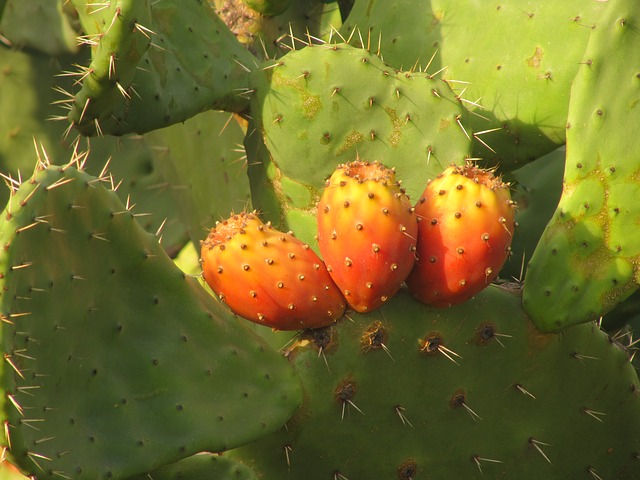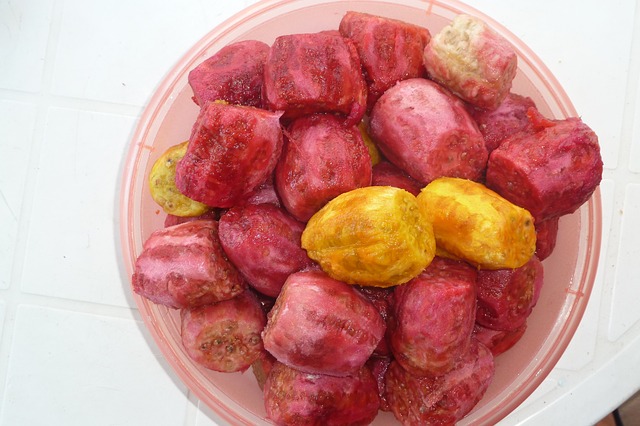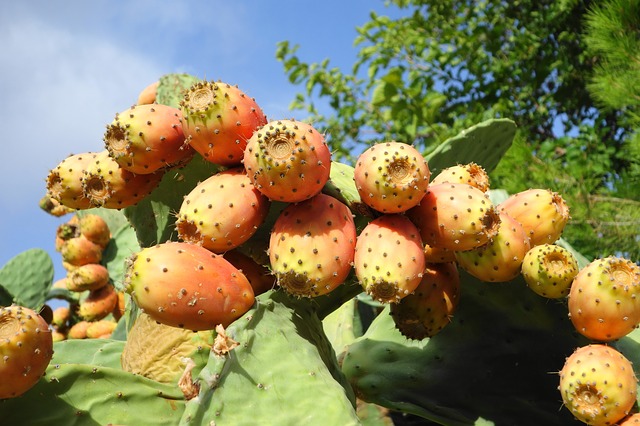Prickly Pear: Origins - Consumption - Nutrition Facts - Health Benefits
|
|
|
Contents
- Geographic origin and regions grown
- Common consumption today
- Nutrition Facts: Vitamins, minerals and phytochemical components
- Health Benefits: Medicinal uses based on scientific studies
- Bibliography
Geographic Origins and Regions Grown

Yes, the prickly pear is an edible fruit once it has been peeled, delicately of course. Now, most people know this is a cactus but somewhere the knowledge about it bearing edible fruit is usually lost. Prickly pear is in the Opuntia genus in the cactus family (Cactaceae), known as nopal. In Sicily it is called "ficurinnia" meaning "Indian fig".
Common Consumption Today
Peel carefully removing the small spines on the peel before consuming. Do I really need to remind myself of that? Well if that isn’t enough to knock your socks off, try eating something whose fruit is called "tuna". But don’t give up on it yet, because you’ll be encouraged to know that it is used in candy making. Prickly pear is commonly used for jellies and beverages as well.
Nopales, the young stem segments, are edible in all species of Opuntia. It takes time to prepare with all those prickly bits. However the young prickly pads are enjoyed in Mexico in salsa, salads and omelets.
For non-edible products, the liquid-gel of a prickly pear-cactus is beneficial to hair care and can be used like a conditioner.
Nutrition Facts: Vitamins, Minerals and Phytochemical Components

Containing a great source in vitamin C and flavonoids and low in sodium and calories, the prickly pear also contains calcium, potassium, magnesium and the amino acid taurine.
This fruit is a great provider of fiber, and everyone could do with more fiber. Its fiber shows similarities to a soluble fiber which lowers cholesterol. The American Heart Association has done research using the prickly pear to help manage cholesterol levels.
Health Benefits: Medicinal Uses Based on Scientific Studies
Traditionally, the prickly pear-cactus has been used as a panacea for over 100 different ailments. Poultices made from the cactus long have been used in some cultures to fight infection and speed healing of wounds, due to the high vitamin C and flavonoid content.
The prickly pear is a bountiful provider of minerals. These nutrients are often recorded as important to the health of the heart and brain. This fruit is also known to be great in flavonoids, and antioxidants that keep arteries healthy. It is possible that the pectin contained in the pulp can lower the bad levels of cholesterol while leaving the good levels cholesterol unchanged.
The stem can be used to treat type 2 diabetes (1), (4), diarrhea, and stomach ache. Some researchers have shown a glucose lowering effect of some species and not others so further research is needed to conclusively know. In addition, some confusion may arise for a shopper when buying nopal since it is impossible to know which species is at the market, so self treatment may not be viable.

In addition to this research, scientific studies have also been done on the antiviral properties of the cactus to treat herpes, influenza, and HIV, as well as its use in treating obesity (2), gastrointestinal disorders, and skin ailments.
It may also reduce alcohol-induced hangovers (3), (5). However results are mixed and research will continue in regards to its benefits to hangover sufferers and their symptoms of dry mouth, nausea, loss of hunger and inflammation. Studies are based on subjects ingesting the prickly pear extracted five hours before drinking. I suppose it is best to tackle peeling the prickly pear before drinking anyway.
In Mexico, prickly pear pills and powders are available everywhere. However the cactus is mainly cultivated for food consumption. It is thought that eating it is the way to gain the most from the plant in the way of health benefits.
Bibliography
1. Bwititi, P., Musabayane, C. T., & Nhachi, C. F. B. (2000). Effects of Opuntia megacantha on blood glucose and kidney function in streptozotocin diabetic rats. Journal of Ethnopharmacology, 69(3), 247-252.
2. Frati-Munari, A. C., Fernandez-Harp, J. A., de la Riva, H., Ariza-Andraca, R., & del Carmen Torres, M. (1983). Effects of nopal (Opuntia sp.) on serum lipids, glycemia and body weight. Archivos de investigacion medica, 14(2), 117-125.
3. Pittler, M. H., Verster, J. C., & Ernst, E. (2005). Interventions for preventing or treating alcohol hangover: systematic review of randomised controlled trials. British Medical Journal, 331, 1515-1518.
4. Rayburn, K., Martinez, R., Escobedo, M., Wright, F., & Farias, M. (1998). Glycemic effects of various species of nopal (Opuntia sp.) in type 2 diabetes mellitus. Texas Journal of Rural Health, 16(1), 68-76.
5. Wiese, J., McPherson, S., Odden, M. C., & Shlipak, M. G. (2004). Effect of Opuntia ficus indica on symptoms of the alcohol hangover. Archives of Internal Medicine, 16(12), 1334-1340.
Disclaimer
Nutritiousfruit.com provides this website as a service. Although the information contained within the website is periodically updated, no guarantee is given that the information provided is correct, complete, and/or up-to-date. The materials contained on this website are provided for general information purposes only and do not constitute legal or other professional advice on any subject matter. Nutrtiousfruit.com does not accept any responsibility for any loss, which may arise from reliance on information contained on this website. The information and references in this website are intended solely for the general information for the reader. The content of this website are not intended to offer personal medical advice, diagnose health problems or to be used for treatment purposes. It is not a substitute for medical care provided by a licensed and qualified health professional. Please consult your health care provider for any advice on medications.
Didn't find what you were looking for? Search here...

Amazon Search Box:
Did you like this page?
|
|
|




